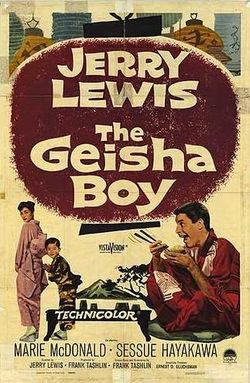
GEISHA BOY
US, 1958, 98 minutes, Colour.
Jerry Lewis, Marie Mac Donald, Barton Mac Lane, Sessue Hayakawa, Suzanne Pleshette.
Directed by Frank Tashlin.
The Geisha Boy is one of Jerry Lewis's earliest solo efforts. He produced the film. It was written and directed by his frequent collaborator (also in Dean Martin days), former cartoonist turned director Frank Tashlin (Artists and Models, Rock a Bye Baby).
The plot of this film is quite slight - Lewis as a magician out of work joining up on a U.S.O. entertainment troupe, causing havoc for the glamorous star, encountering the young Japanese orphan and his aunt and delighting children. There are the usual mishaps and muggings - even in the final sequence. The film is prolonged rather than pacy and there is a dwelling on the sentimental aspects of the film with Lewis and the little Japanese boy.
There are also some 'in' jokes about Marlon Brando in Sayonara as well as Sessue Hayakawa reminded of his role in The Bridge on the River Kwai (building a model of this bridge in his garden to the Colonel Bogie March). The reference is made obvious by the insertion of a quick clip showing Alec Guinness from the film.
The film also shows Suzanne Pleshette at the beginning of her career. More gentle than many other Lewis vehicles - but with his usual mishaps, face-making and portrayal of the American little man.
1. An entertaining comedy? The 1950s? Personality? Comic style? The popularity of Jerry Lewis?
2. Colour photography, America, Japan - and the touristic style of the film (with the joke about tourist films)? Musical score and the theme, sentiment? Special editing for Jerry Lewis's jokes and mugging?
3. The title and the focus on Japan? American- Japanese relations by the 1950s? The American occupation, the entertainment of the troops? The bonds between Americans and Japanese - baseball, culture, the Americanising of Japan? Japanese traditions, politeness? The Japanese customs and jokes - especially the baths, restaurants?
4. Lewis's style as Gilbert - the would-be magician? The little man victim? His entanglement with the star and causing her humiliation? The difficulties of the plane trip? The friendship with the lady sergeant? Her helping him - and falling in love with him? His reliance on his rabbit Harry - and the film's focus on Harry? The jokes about rabbits - and the humanising of the rabbit? The encounter with the little boy because he could laugh at the mishaps? His attractive aunt? The boyfriend baseballer and the attack at the bath, the flooding of the street? Going on tour and delighting the children? The entanglements with the military? The little boy following him, the return trip, the difficulties and Gilbert's returning to Japan? The jokes about stowing away?
5. The aunt and her attractiveness, her joining Gilbert with the little boy in the final act? The comparison with the American sergeant? The contrast with the self-centred glamorous American actress - and her continued accidents?
6. The military, overseas entertainment - and the humour of Bob Hope being dubbed into Japanese on television? The military personnel - co-operative, exasperated?
7. The character of Harry the rabbit - the amount of attention given to, him (and the writer-director's background in cartooning)? The chase, the humanising of Harry e.g. his standing with crossed legs, sunbaking and being sunburnt, clothes? Participation in the performances? And the rabbit joke at the end - Harry to Harriet?
8. Jerry Lewis's style of comedy and its appeal? The broad sweep, the little man victim, accidents and tangles, voice and pulling faces, songs and dances, sentiment and the touch of magic? successful here? In comparison with his other films?